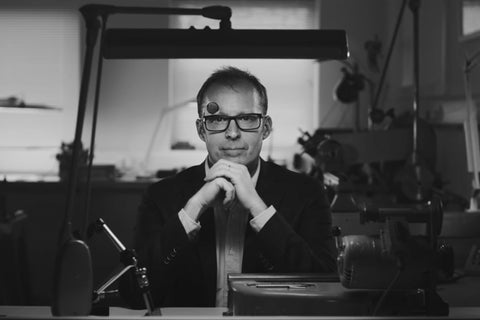Roger W. Smith OBE is recognised as one of the greatest watchmakers of the modern era. The only watchmaker to work as an apprentice to, and alongside, the late Dr George Daniels, Roger has been producing watches on the Isle of Man for over two decades. In that time, he has been fine-tuning and perfecting the escapement that Daniels first dreamt of, the Co-Axial, using the same principles as his mentor, while continuing to strive for a vision of modern British watchmaking. Today, he remains the only workshop which creates complete watches and movements in the British Isles.
The open-dial version of the Series 2 was first introduced in 2008, with the first pieces leaving the workshop in 2010. Where previous iterations of the Series 2 have been more restrained and traditional, this open-dial version is Smith's compelling attempt at disrupting the buttoned-up image of British watchmaking. One of the smallest "production watches" in the world, less than a dozen Series 2 pieces have been executed with open-dials to date, with the collection having since been given the designation "Series 5".
Pushing forwards the Co-Axial
The Co-Axial escapement was devised in the early 1970s and patented in 1980, with its design based on a series of experimental escapements that started in 1969. It was designed to improve the mechanisms’ long term performance by radically changing the nature of its inner workings. This was the first practical invention since the lever escapement, created by Thomas Mudge in 1755, thus representing an important advancement in the dynamics of the watch. By re-designing the function of the components during impulse, the Co-Axial escapement operates without sliding friction. As a consequence, unlike a conventional watch, the rate is unaffected by the viscosity of lubricants, which can vary constantly with temperature, humidity, and age.
In 2006, Smith began working on his own interpretation of his mentor's design, culminating in the first significant development of the Co-Axial escapement. He spent years studying ways to improve its efficiency and accuracy. Initially combining two wheels, Smith created his first single-wheel design in 2010. Through successive versions, it was discovered that the lighter the escape wheel, the better it performed.
This example houses the latest example of the single Co-Axial escapement, which is the lightest and smallest version to date. This was first introduced in 2015, and marks another key step in Smith's long-standing journey to carry forth Daniels' legacy. In Roger’s own words,
"Horology isn’t about standing still and accepting things as they are. It’s about pushing things forward and making small improvements wherever we can."
The Design
The open dial features a thin, outer chapter of engraved, black minute markers, with corresponding Roman numerals indicating the hours. These numerals appear to float over the rest of the dial, and are in a deep purple tone that complements the hands. The dial itself features English-style flourishes, with frosted and gilded plates, gold chatons, and flame-coloured screws. All parts are hand-crafted from beginning to end; including the slender, purple-flamed gold hour and minute hands, tipped with spades. A raised cartouche at twelve o'clock references "R. W. SMITH" in black engraving, and likewise for the reverse of the watch.
A power-reserve indicator sits at 10 o'clock, with a purple-flamed up/down hand, with a hanging chapter made from silver. The large, sub-seconds register placed at six o'clock is also enclosed within a grained silver seconds chapter with drilled dots to mark the seconds, while the hand features a traditional counterbalance on the other end.
The beautiful movement is revealed through the sapphire caseback, and is very much inspired by the British style of pocket watches of Tompion, Graham and Arnold. Much like the dial, the movement also shows multiple layers of depth. It has a custom, English, floral-engraving, a raised barrel bridge and balance cock and frosted and gilded plates. This, together with the dominating three-quarter main plate, is a testament to Roger W. Smith's commitment to traditional English watchmaking.
The round, platinum case measures 40 mm in diameter, with a sapphire glass on the front and back. The caseback is engraved with "SERIES 2" and the watch's serial number, as well as bearing the traditional and maker's own hallmarks.





















































































































































































































